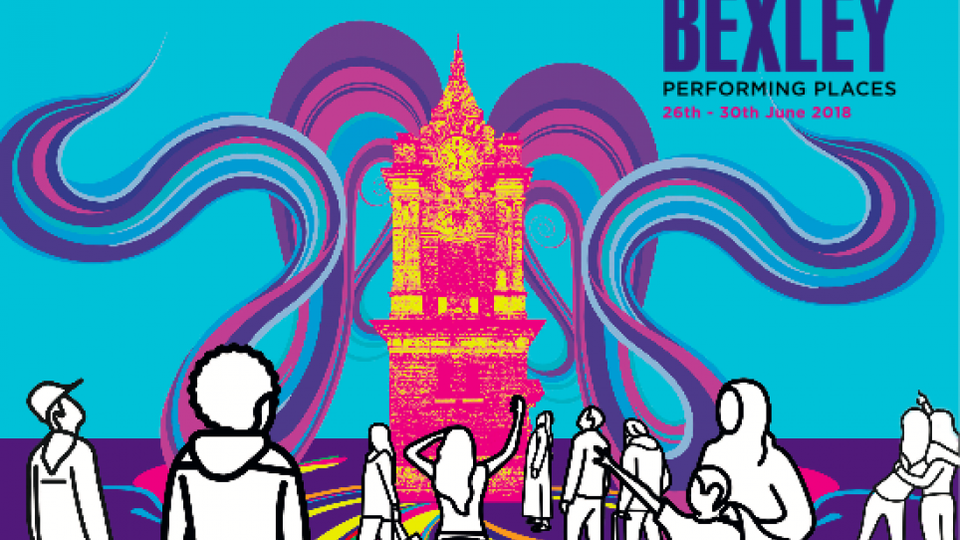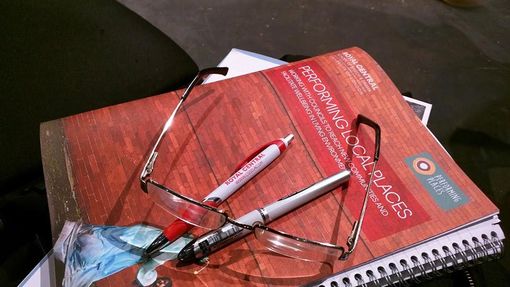Image

Practicing Place Care
Since 11 May 2018, the Performing Places Bexley team has organised 20 talks and workshops and asked more than 1000 participants to ‘decode’ communications from Par Bexia. We have visited primary and secondary schools, community organisations and large-scale community events. This week, we move into an intensive week of Place activities leading up to the main event on 30 June 2018, on Bexleyheath Broadway.
Performing Places Bexley: Practicing Place Care
Variations of beeping noises and ‘good screechy noises’ filled the room as the young participants responded to an invitation by Clara to listen, and relay, communications from Par Bexia to Bexley. Clara is a Vist (an archivist and an inventor) and Par Bexia is a version of Bexley, existing in a parallel universe. In one of the workshops, as we were talking about parallel universes, one participant imagined a Par Bexia where she could play freely, unencumbered by the responsibilities of being a young carer.
Since 11 May 2018, the Performing Places Bexley team has organised 20 talks and workshops and asked more than 1000 participants to ‘decode’ communications from Par Bexia. We have visited primary and secondary schools, community organisations and large-scale community events. Every group encountered thus far has offered a slightly different approach to interacting with Par Bexians. Although most generally scream with delight and step back when they hear strange noises emitting from the ‘pod’, one young participant from a group of young carers devised a way of communicating with the pod, inviting it to move different parts as a representation of ‘yes’ or ‘no’. Another adult participant from a mental health support group was convinced that there was a baby Par Bexian in the pod and started stroking the pod and speaking reassuringly to it. Although these participants understood that Par Bexia was an imagined part of a parallel universe, they readily participated in elaborating the imagination of Par Bexia with their own understanding of parallel universes. While most imaginations of Par Bexia were, unsurprisingly, shaped by popular films and television shows of how beings from another planet might attempt to interact with humans, these participants seemed to adopt modes of care that were familiar to their everyday.
When prompted to think about how one might care for place, most young participants offered the same answer, ‘Do not litter’. But if we understand ‘place’ as a relationship with a location that exceeds our functional use of the physical ‘site’ then we must also consider the psychological associations we form of this site. These emotions and memories are often shaped by the relationships we form (or choose not to form) with others in this site. Therefore, care for Bexley, as a place, must exceed the commitment to maintain its cleanliness. In thinking about place care, we must also attend to the relationships we form with others, in place.
When prompted to describe the things they’d like the Par Bexians to know or feel about Bexley, one 13 year-old participant from St Catherine’s Catholic School said she hoped the Par Bexians would experience ‘a sense of community’. She felt that Bexleyheath Broadway was one place in Bexley used by ‘different people’ of ‘different ages’. Although she enjoyed interacting with other young people her age from different schools, she also observed that there should be more interaction between adults and youths and felt that it would be better if people did ‘not just keep to their groups’. Being engaged in acts of place care in Bexley might therefore be understood as encouraging positive interactions between different communities, nurturing relationships that create a sense of ease for everyone, in place.
Nigel Thrift suggests that even though ‘misanthropy is a natural condition of cities, one which cannot be avoided and will not go away and may even have been amplified by the modern mass media’ (Thrift 2008: 209), kindness can be ‘built into the spaces of cities…cities have to be designed as if things mattered, as if they could be kind too’ (215). Thrift suggests that this kindness might be built into our everyday interactions through ‘various kinds of practical affective politics’ that might stimulate kindness through different forms of spatial play that ‘use uban space in ways that will produce new understandings of the moment’ (219, emphasis in original).
However, this invitation to engage in acts of place care through spatial play can be intimidating for most people. Maurice Hamington, in ‘The Will to Care: Performance, Expectation, and Imagination’ (2010) suggests that being engaged in the regular practice of care is ‘an essential element in cultivating the will to care’ for strangers (Hamington 2010: 16). Borrowing from Hamington’s ideas on altruism, offering non-threatening opportunities for people to practice place care through byte-sized experiences of spatial play might therefore work towards the development of an individual’s ability to care for place, nurturing the will to initiate future interventions.

With Performing Places Bexley, we have planned a series of interactive performances and games that are designed to initiate intergenerational interactions along Bexleyheath Broadway. These positive interactions will hopefully initiate the formation of relationships where different communities might come together to create a feeling of belonging for everyone. From 26 to 30 June, Performing Places Bexley will extend this imaginary narrative of Par Bexia and its relationship with Bexley using place practices that will take the form of participatory performances and games. By interweaving the place narratives of Par Bexia and Bexley we hope to encourage interactions that open up ways of re-experiencing Bexleyheath Broadway as a place at ease with itself.
Note: This blog is written by Adelina Ong.
25 June 2018
References
Hamington, M. (2010) ‘The Will To Care: Performance, Expectation, And Imagination’, Hypatia, Vol. 25, No. 3: 675–695. (accessed 28.4.17).
Thrift, N.J. (2008) Non-Representational Theory: Space, Politics, Affect, Milton Park, Abingdon, Oxon ; New York, NY, Routledge.

